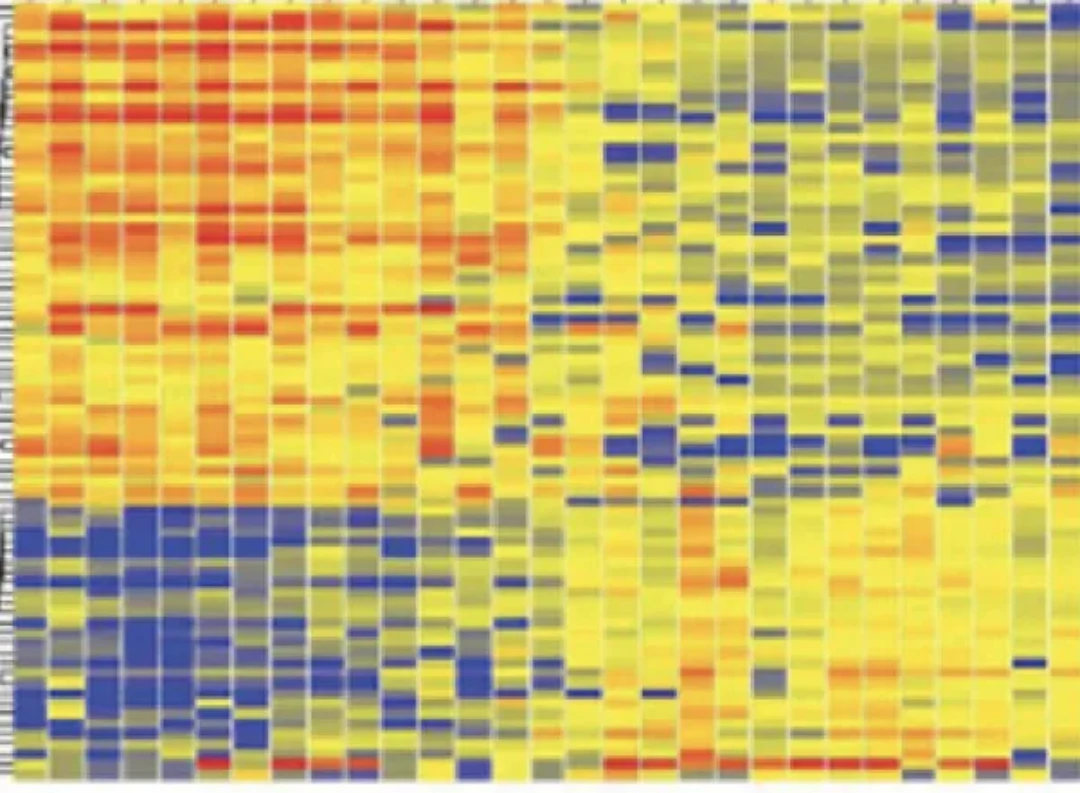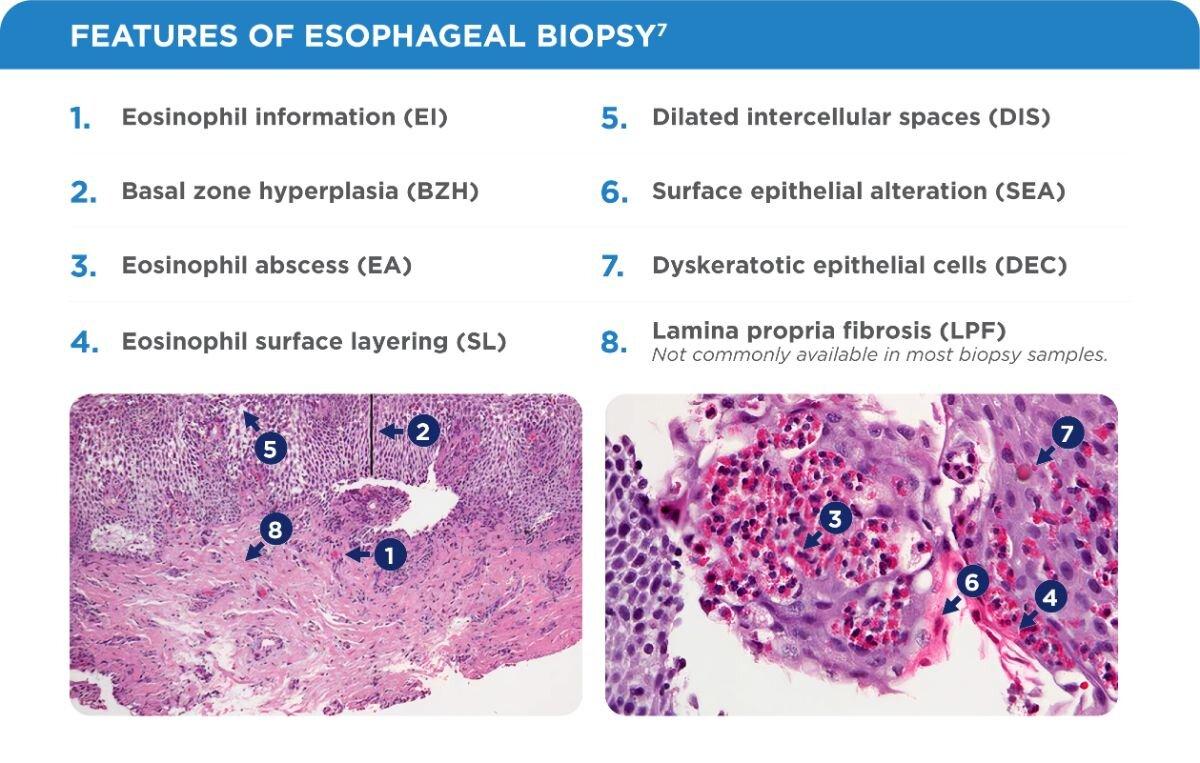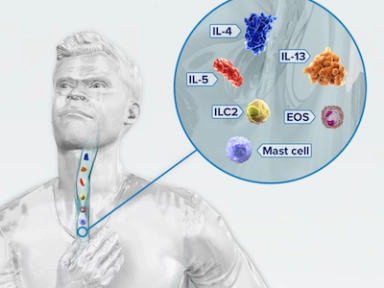Measures of disease severity in eosinophilic esophagitis (EoE)
.jpg/jcr:content/Banner%20(1).jpg)
Peak esophageal intraepithelial eosinophil counts
Most studies use peak esophageal intraepithelial eosinophil counts (eosinophils per high-power field, or EOS/HPF) to determine histologic outcome, using both percent change in peak EOS/HPF as well as proportion of patients achieving a treatment response, as shown below.4
How treatment responses are classified4
- <1 EOS/HPF
- (Normal biopsy) Considered a complete histological remission
- ≥1 to <15 EOS/HPF
- (Reduced eosinophilia) Considered the histologic response threshold
- ≥15 EOS/HPF
- (Persistent eosinophilia) Considered a non-response
Peak EOS/HPF is the most common histologic measure of disease severity4
<1 complete normalization
Normalized enrichment score
The Normalized Enrichment Score (NES) is an additional assessment to confirm the diagnosis using gene expression of interest in eosinophilic esophagitis compared with healthy controls.5
How NES is assessed
The EoE diagnostic panel, or EDP (shown below), is a molecular diagnostic test that differentiates patients with eosinophilic esophagitis from normal controls based on 94 EoE genes; a heatmap shows which gene transcripts are upregulated (red) relative to normal controls (blue).5

EoE Diagnostic panel heatmap5
Patients with EoE (Right part)
Normal controls (Left part)
NES scores appear to normalize in EoE patients after successful treatment6
EoE-HSS Composite score
The Eosinophilic Esophagitis Histologic Scoring System (EoE-HSS) is a scoring system that measures histologic changes in the esophagus beyond eosinophil count, including barrier function and remodeling, grading 8 features of eosinophilic esophagitis to quantify frequency, severity, and extent of abnormalities.7
How NES is assessed
Pathologists score histological degree of abnormality (grade) and histological extent of pathologic severity (stage) using a 4-point scale for each feature (0=normal; 3=most severe or extensive). The maximum possible grade or stage score for each biopsy is 24.7

EoE-HSS Composite scores are more predictive of treatment response than eosinophil count alone4,7
0 (normal)
24 (most severe or extensive)
- O’Shea KM, Aceves SS, Dellon ES, et al. Pathophysiology of eosinophilic esophagitis. Gastroenterology. 2018;154(2):333-345. doi:10.1053/j.gastro.2017.06.065
- Hudgens S, Evans C, Phillips E, Hill M. Psychometric validation of the Dysphagia Symptom Questionnaire in patients with eosinophilic esophagitis treated with budesonide oral suspension. J Patient Rep Outcomes. 2017;1(3):1-11. doi:10.1186/s41687-017-0006-5
- Dellon ES, et al. Dupilumab improves health-related quality of life and reduces symptom burden in patients with eosinophilic esophagitis: results from part A of a randomized, placebo-controlled, three-part, phase 3 study. Poster presented at: 2021 Virtual Annual Meeting of the American Academy of Allergy, Asthma, and Immunology (AAAAI); February 26 - March 1, 2021.
- Dellon ES, Gupta SK. A conceptual approach to understanding treatment response in eosinophilic esophagitis. Clin Gastroenterol Hepatol. 2019;17(11):2149-2160. doi:10.1016/j.cgh.2019.01.030
- Wen T, Stucke EM, Grotjan TM, et al. Molecular diagnosis of eosinophilic esophagitis by gene expression profiling. Gastroenterology. 2013;145(6):1289-1299. doi:10.1053/j.gastro.2013.08.046
- Dellon ES, Veerappan R, Selitsky SR, et al. A gene expression panel is accurate for diagnosis and monitoring treatment of eosinophilic esophagitis in adults. Clin Transl Gastroenterol. 2017;8(2):1-8. doi:10.1038/ctg.2017.2
- Collins MH, et al. Newly developed and validated eosinophilic esophagitis histology scoring system and evidence that it outperforms peak eosinophil count for disease diagnosis and monitoring. Dis Esophagus. 2017;30(3):1-8. doi:10.1111/dote.12470
- Wechsler JB, et al. Eosinophilic esophagitis reference score accurately identifies disease activity and treatment effects in children. Clin Gastroenterol Hepatol. 2018;16(7):1056-1063. doi:10.1016/j. cgh.2017.12.019
- Hirano I, et al. Endoscopic assessment of the oesophageal features of eosinophilic oesophagitis: validation of a novel classification and grading system. Gut. 2013;62(4):489-495. doi:10.1136/ gutjnl-2011-301817
- Lucendo AJ, Molina-Infante J, Arias Á, et al. Guidelines on eosinophilic esophagitis: evidence-based statements and recommendations for diagnosis and management in children and adults. United European Gastroenterol J. 2017;5(3):335-358. doi:10.1177/2050640616689525
- Safroneeva E, Straumann A, Coslovsky M, et al; International Eosinophilic Esophagitis Activity Index Study Group. Symptoms have modest accuracy in detecting endoscopic and histologic remission in adults with eosinophilic esophagitis. Gastroenterology. 2016;150(3):581-590.e4. doi:10.1053/j.gastro.2015.11.004
- COREOS Collaborators: Ma C, Schoepfer AM, et al. Development of a core outcome set for therapeutic studies in eosinophilic esophagitis (COREOS) [published online ahead of print, 2021 Jul 6]. J Allergy Clin Immunol. 2021;S0091-6749(21)01059-9. doi:10.1016/j.jaci.2021.07.001
